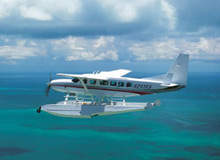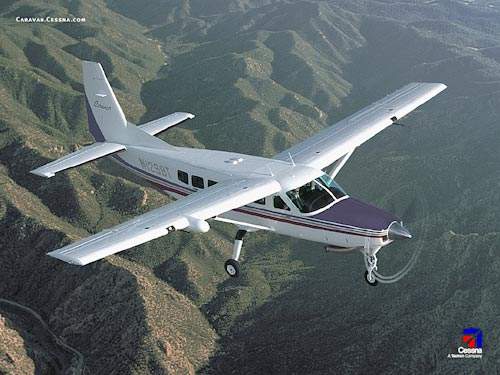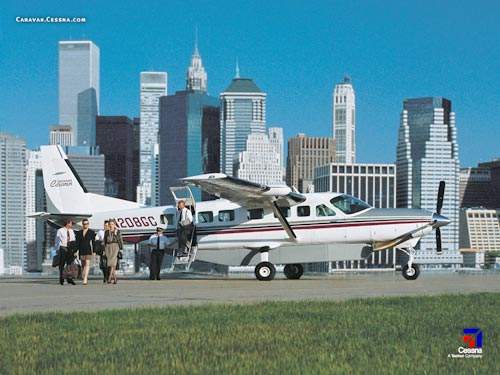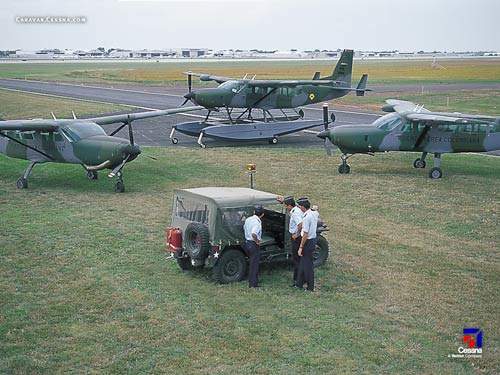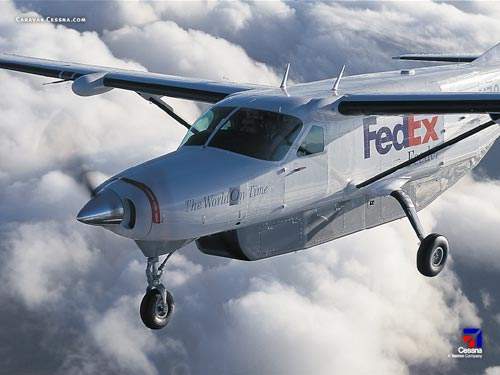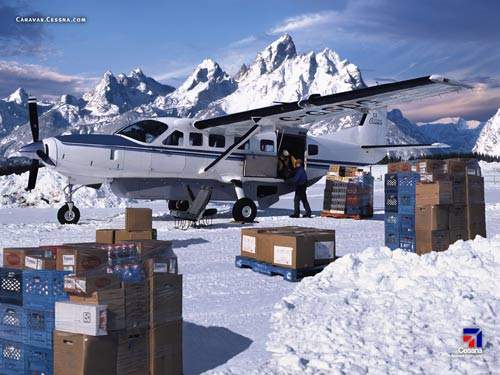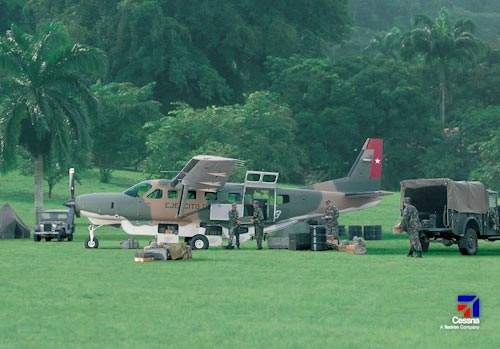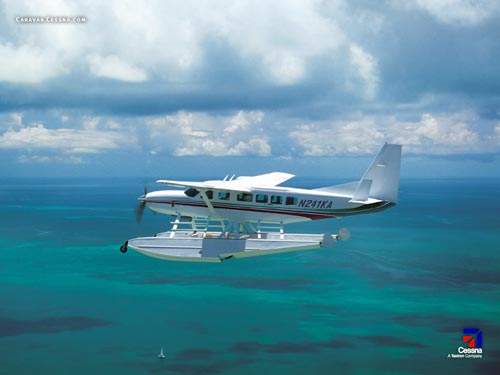The Cessna 208 Caravan is an unpressurised single-turboprop light utility and passenger aircraft manufactured by Cessna Aircraft Company in Wichita, Kansas. The aircraft is in operation in 70 countries worldwide and is known for its capability to use rough fields and airstrips, its economical operation and versatility for high speeds and heavy loads.
The aircraft, with braced high wing and tapered wings and tailplane, has been selected for use by several governments as well as for cargo, air passengers, military and paramilitary roles, for patrol, surveillance and rescue.
Over 1,500 Caravans have been delivered since the Caravan 208A entered service in 1985. The 208B stretched Super Cargomaster entered service with Federal Express in 1986 and was upgraded with a new Pratt & Whitney PT6A-114A engine in 1991.
Current production versions are the Caravan 625 (the basic Caravan with uprated engine), the Grand Caravan (a 14-passenger version of the stretched 208B), the Super Cargomaster and the Caravan Amphibian.
The Caravan is certified in 100 countries. The fleet has accumulated more than 13m flight hours. The Caravan successfully completed and celebrated 25 years of service in 2010.
Two Caravans were destroyed in separate incidents in 2011. One Caravan belonged to Missinippi Airways and the other was operated by the Brazilian Air Force.
Super Cessna Cargomaster
Federal Express operates a fleet of 39 208A Cargomasters and 260 208B stretched Super Cargomasters. The Cargomaster is an all-cargo variant with no side windows and a large cargo door. The aircraft is fitted with additional cargo tiedown points, cargo nets and an underfuselage cargo pannier.
A stretched version, the 208G, includes an additional fuselage section or plug to the aft of the wing providing an extra 1.22m of cabin length. The stretched version can carry a payload of 1,587kg. Federal Express uses a two-section over and under cargo door, which can be removed, fixed open or opened in flight for cargo airdrops.
Amphibious Cessna 208 Caravan
The landing gear can be fitted with amphibian floats, type Wipline 8000, or ski-landing gear. The Royal Canadian Mounted Police operate the Amphibious 208 Caravan.
Cessna military variants
The military variant carries the US designation U-27A and is used as a troop carrier and cargo airlifter as well as for VIP transportation, air ambulance and medical evacuation, forward air control, infiltration and exfiltration of forces, and as a command center for unmanned air vehicle operations.
U-27A.”
The U-27A is used by the US Central Intelligence Agency and the US State Department. The Caravan 208 is also in service with the Brazilian and Columbian Air Forces and the Chilean Army.
The LICA low-intensity conflict aircraft is fitted with a General Dynamics reconnaissance pod on the underside of the fuselage and a GECAL Gatling gun, 0.50 calibre, on the door. The aircraft can also be fitted with systems for an electronic warfare role.
Cockpit
The cockpit can be fitted with a set of co-pilot instrumentation. The avionics suite is based on the operator’s choice of Honeywell or Garmin avionics.
The Honeywell Silver Crown avionics suite can include a Kings radio flight control system 250, with KWX 56-colour weather radar, KLN 94 global positioning system with a full colour moving map display, a KMD 850 multi function display and a digital KFC 225 autopilot with an altitude preselect command.
The Garmin navigation communications and global positioning system, GNS 340, comprises a GNS 530 wide area active surveillance radar, IFR (instrument flight rules) communications, navigation and global positioning system with a line of communication and glidescope receiver, and a GTX 327 digital transponder for Mode C.
In September 2007, Cessna announced that all new Caravan models would be fitted with a glass cockpit which consists of Garmin G1000 integrated avionics system.
This includes the GFC700 integrated, dual-channel digital autopilot flight control system, three 10in displays (two primary flight displays and one multifunction display), flight director, go-around mode, wide-area augmentation system (WAAS) and SafeTaxi, a graphical representation of the aircraft in the airport environment. Optional features include TAWS-B, XM radio and XM weather.
The Garmin G1000-equipped caravan received Federal Aviation Administration (FAA) certification and began deliveries in April 2008. European Aviation Safety Agency (EASA) certification followed in July 2008.
Orders and deliveries
In February 2010, Cessna delivered five Grand Caravans to Susi Air as part of an order placed by it for 30 Grand Caravans in June 2009. It is expected to deliver a total of 11 in 2010 and the remaining by the end of 2011.
Air St Kitts-Nevis received a Grand Caravan in September 2010. The company also ordered another Grand Caravan in 2010.
Two Grand Caravans were delivered to Russia’s AirGEO in December 2010.
In May 2011, Cessna received orders for three Caravans from an unknown based in Italy.
Cabin
The cabin can be configured to carry nine passengers or up to 14 passengers with a FAR Pt 23 waiver. The cabin is heated and ventilated and can be optionally fitted with air conditioning.
The 9.66m³ cabin is 4.57m in length and 1.57m in width. The cabin is fitted with a flat floor for ease of manoeuvring cargo and can accommodate two standard D-size cargo containers or ten 208l drums. The floor is fitted with cargo tracking attachments.
In May 2010, Cessna announced the offering of new seat options to the current Caravan owners to upgrade their Caravans with the new seating facility.
Cessna engines
The aircraft is powered by a single Pratt&Whitney Canada PT6A-114A turboprop engine developing 503kW. The engine drives a three-bladed constant speed reversible pitch and feathering propeller. The wing fuel tanks hold 1,257l of usable fuel. The cruise speed at 3,000m is 340km/h. The maximum range for flight at 3,050m with 45 minutes of reserves is 1,780km.
The aircraft’s de-icing system includes electric propeller de-icing boots, an electrically heated windscreen, heated pitot tube, ice detection systems and a backup electrical system.TKS ice protection from Aerospace Systems & Technology is available on Caravans with cargo pods from July 2009.

